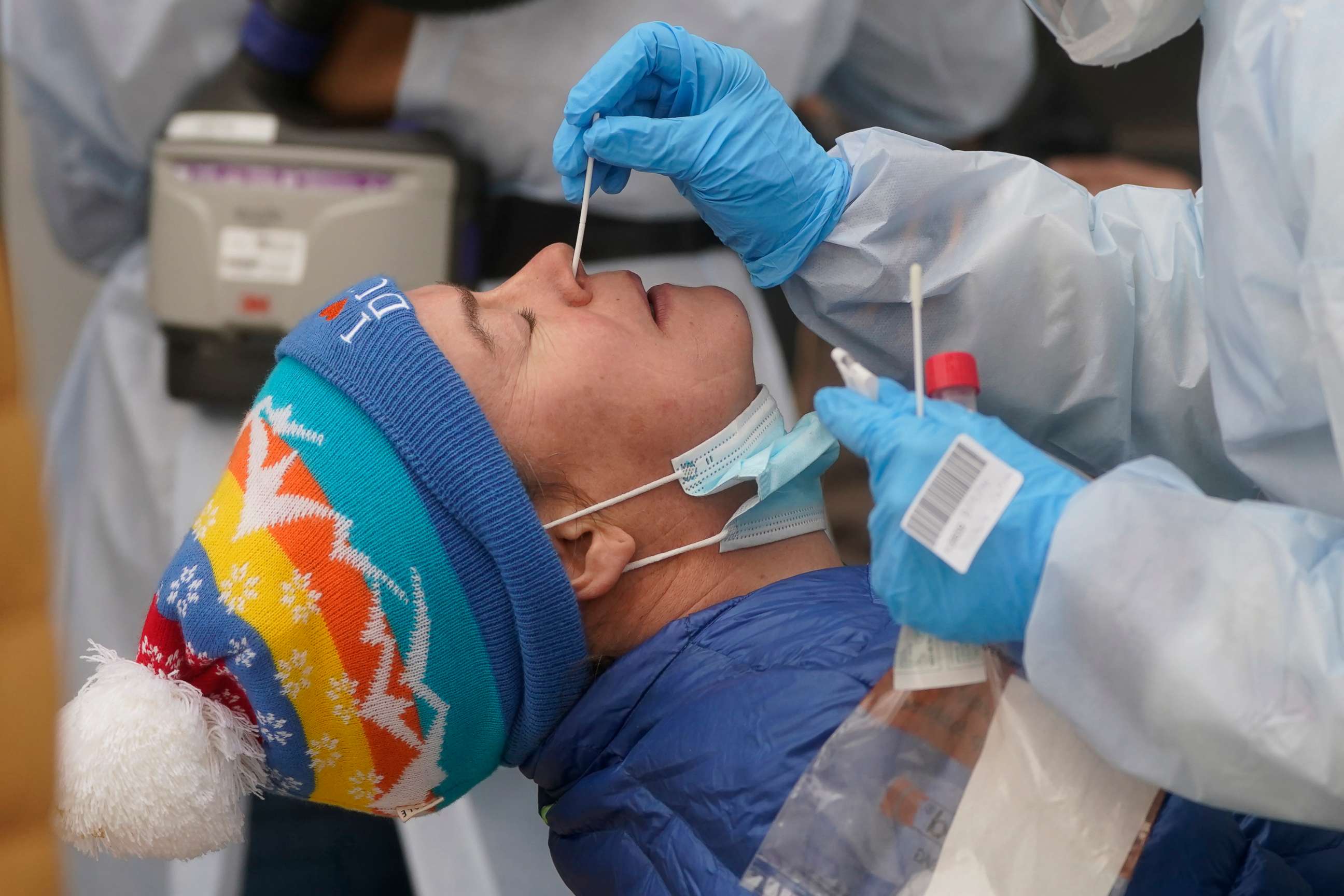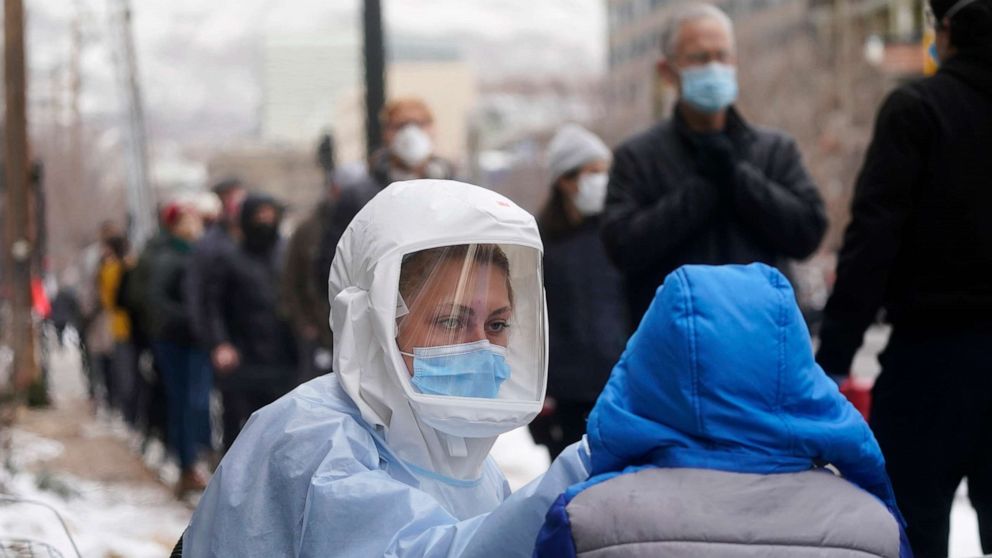Overwhelmed Utah battles omicron surge with limited testing
The state is seeing record COVID-19 hospitalizations.
As the highly contagious omicron variant drives up COVID-19 infections around the country, demand for testing has also soared, with long lines at sites and sold-out at-home rapid tests common. At the same time, staffing shortages and supply chain issues have also challenged testing efforts, from temporarily closing sites to delaying lab results.
In Utah, state officials said last Friday that a combination of high testing demand and staffing shortages, as well as a delayed shipment of tests, had maxed out their testing capacity, which peaked last week at over 54,000 tests reported in one day -- more than double what the state was typically reporting daily throughout the fall. The state is now temporarily prioritizing testing for certain populations while encouraging others who are symptomatic to assume they have COVID-19 and isolate for five days.
In the days after the new guidance was announced, the number of tests logged by the state had dropped, though turnout may have also been impacted by the holiday weekend and a new appointment-only model at several sites, a health department spokesperson said. From Saturday to Wednesday, the number of COVID-19 tests reported fluctuated from as low as about 20,700 to upwards of over 46,700 tests a day, state data shows. After reporting a record number of new cases last week, surpassing 13,500, the seven-day average for new cases was around 10,700 as of Wednesday. Until now, the state hadn't topped 5,000 new cases a day.
Public health experts are cautiously optimistic the unusual guidance for symptomatic people to isolate without test results should help slow the explosive growth of cases -- as long as residents follow it. Utah's testing crisis also demonstrates the importance of interventions like vaccination -- -- about 35% of eligible state residents are not fully vaccinated -- and masking to limit transmission, and the need to be prepared testing-wise for potential surges in the future, experts said.
Symptoms a 'guiding principle'

To address surging testing demand exacerbated by staffing shortages, some state-run testing sites earlier this month pivoted to appointment-only, while others started handing out at-home tests to those waiting in hours-long lines. That was helping, state officials said, until there was a testing shortage.
"The normal supply of tests that we had already ordered did not come to us, and so that that became another constraint," Utah Gov. Spencer Cox said during a Jan. 14 press briefing. "Over the next week or two, we'll be getting hundreds of thousands of the tests that we have ordered. ... But in the meantime, until those tests come in, we have to look at things a little differently."
For now, the state is recommending that those who have any symptoms skip getting a test, assume they have COVID-19 and isolate for five days. State health officials advised seeking testing when leaving isolation and then wearing a mask for five days.
"There are so many cases going around. Now we know if you have symptoms, you most likely have COVID. And so the benefit of getting that test is really decreased," Dr. Leisha Nolen, state epidemiologist, said during the briefing. "What is more important is keeping you away from other people so you don't transmit it."
Those still encouraged to seek testing include the elderly, people with "significant underlying conditions," so they can get treatment if needed, those who work in health care or congregate living settings and have been exposed or are symptomatic, people visiting someone who is vulnerable and travelers who need proof of a negative test.
Whether you're unable to get a test or awaiting results, symptoms should be the "guiding principle" on whether to start isolating, said John Brownstein, Ph.D., an epidemiologist at Boston Children's Hospital and an ABC News contributor.
"Because we're in a time period where we have shortages of testing, long wait times, even delays in reporting results, using symptoms as an indicator of infection is important," he said. "Regardless if you get a test or not, you should assume when you have symptoms that you are infected and isolate accordingly. That really is the only way to really drive down transmission."
Commonly reported symptoms of the omicron variant include sore throat, cough, runny nose, headaches and fatigue. Those are similar to prior versions of the disease.
Positive cases will be missed if people don't seek out testing at a site. Dr. Angela Dunn, executive director of the Salt Lake County Health Department, noted on Twitter after the guidance was issued that it may appear as if cases have plateaued, and that she was "skeptical about the utility of case counting for the next couple weeks." But undercounting has been the case throughout the pandemic, especially with the use of at-home rapid tests, which largely go unreported, Gigi Kwik Gronvall, a senior scholar at the Johns Hopkins Center for Health Security, told ABC News.
Beyond cases, other data points like hospitalizations and wastewater sampling can help "give you an indication of the direction of the pandemic," she said.
COVID-19 hospitalizations in Utah have risen steeply in recent weeks. As of Thursday, 756 patients across the state were reported hospitalized due to COVID-19, a pandemic high, according to state data. Intensive care unit capacity was also nearing 100%.
Relying on other tools
If people isolate when they have symptoms, "it will help," Dr. Andrew Pavia, chief of the division of pediatric infectious diseases at University of Utah Health and director of hospital epidemiology at Intermountain Primary Children’s Hospital, told reporters during a recent press briefing. Though following through on the guidance is key, he said.
"My concern is when we run out of testing, people don't think they have COVID, they go about their normal activities, and they can contribute more to the spread," he said.
There have been a "wide range of behaviors and response" to recommendations throughout the pandemic, Brownstein said. "We'll have people that will be ultra-conservative and careful with any symptoms, and then of course there will be many people who will ignore guidance, even after getting a positive test result," he said.
With testing limited, Pavia stressed the importance of using other tools available, including masking in public, to reduce spread.
"That's what it's going to take to take some of the pressure off of our critical functions, including hospitals, so that we can get through the worst of this," he said.
Masking is also key given the prevalence of asymptomatic infection; University of Utah Health found from its own COVID-19 testing that the positive test rate among asymptomatic people was nearly 12% in the last week.
"That's just a snapshot that about one in seven, one in eight people that you might come across in any given day likely has COVID and doesn't even know," Russell Vinik, chief medical operations officer at University of Utah Health, said during a university press briefing Wednesday.
The surge has also demonstrated the need for people to be vaccinated and boosted to help reduce transmission and prevent severe illness in the event of a breakthrough infection, Gronvall said.
Around 65% of Utah residents ages 5 and up are fully vaccinated -- around the national average -- and nearly 34.5% of eligible residents have gotten a booster dose, which is behind the national average, according to federal data.
State leaders have encouraged vaccination and masks, though have pushed back against mandates.
Two counties in the state -- Salt Lake and Summit -- have mask mandates in place amid the omicron surge, though a resolution that would overturn them is making its way through the state legislature after passing the state Senate this week. The state had also previously passed a bill banning mask requirements in schools.
Salt Lake County Health Department issued an order requiring people to wear respirators, such as KN95s, when indoors in public as a "stop-gap" to control transmission while encouraging people to get their booster, Nicholas Rupp, a spokesperson for the department, told ABC News.
"We know vaccination and booster is a better long-term intervention for controlling transmission, but everybody getting vaccinated today isn't going to help our case rate tomorrow because it can take a couple of weeks for the vaccine to fully build immunity in your system," he said.
Need to be 'overprepared'

Public health experts said it may be hard to see when the peak is reached in Utah since the state has reached its testing capacity, though they expect the surge to last several more weeks.
"The cases are still very, very high, and hospitalizations will still continue to see increases over the next couple of weeks," Erin Clouse, strategic engagement manager at University of Utah Health, told reporters Wednesday.
In the coming weeks, supplies of treatments like oral antiviral drugs should improve, and testing supply should also catch up. There will be new access points for at-home tests, which can "offload some of the testing capacity," Brownstein said.
"But I think absolutely there will be a recognition on a part of public health that they need to be able to have surge capacity testing to meet the same scale of infection that we saw with omicron," he said.
As Utah contends with its latest surge, the testing capacity shows the need for states to be prepared in case there's another one, Gronvall said.
"There's no law of nature that says that omicron is going to be the last variant," she said. "The best circumstance that we can be in is that we have an overprepared testing infrastructure for the next variant."




